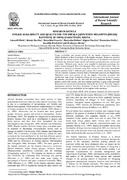| dc.description.abstract | Brian) Kathryh) in three ecosystems of the Impala sanctuary, Kenya was assessed during the wet and dry seasons. The grazing behavior of the impalas was observed to identify the preferred forage species and patterns grazing between seasons and ecosystems. Preferred grass species were sampled to determine percentage dry matter, neutral detergent fiber, acid detergent fibers, and Crude protein. Data was subjected to Analysis of Variance using SAS version 9.0. The results showed that impala sanctuary had 37 different grass species but Cynodon dactylon, Eragrostis curvula, Digitaris scalarum, Eleusine indica, Pennisetum setaceum and Hyparrhenia filipendula were most grazed on by the Impala. Grassland ecosystem had significantly high forage availability during the wet season, but in the dry season the marshes ecosystem was the one with the most nutritious forages. Grazing patterns varied with seasons, with most impalas preferring to graze in the grassland during the wet season and in the marshes during the dry season. The study suggests management practices that favor dominance of species that are most foraged in order to increase forage availability for the impalas in the sanctuary. | en_US |

